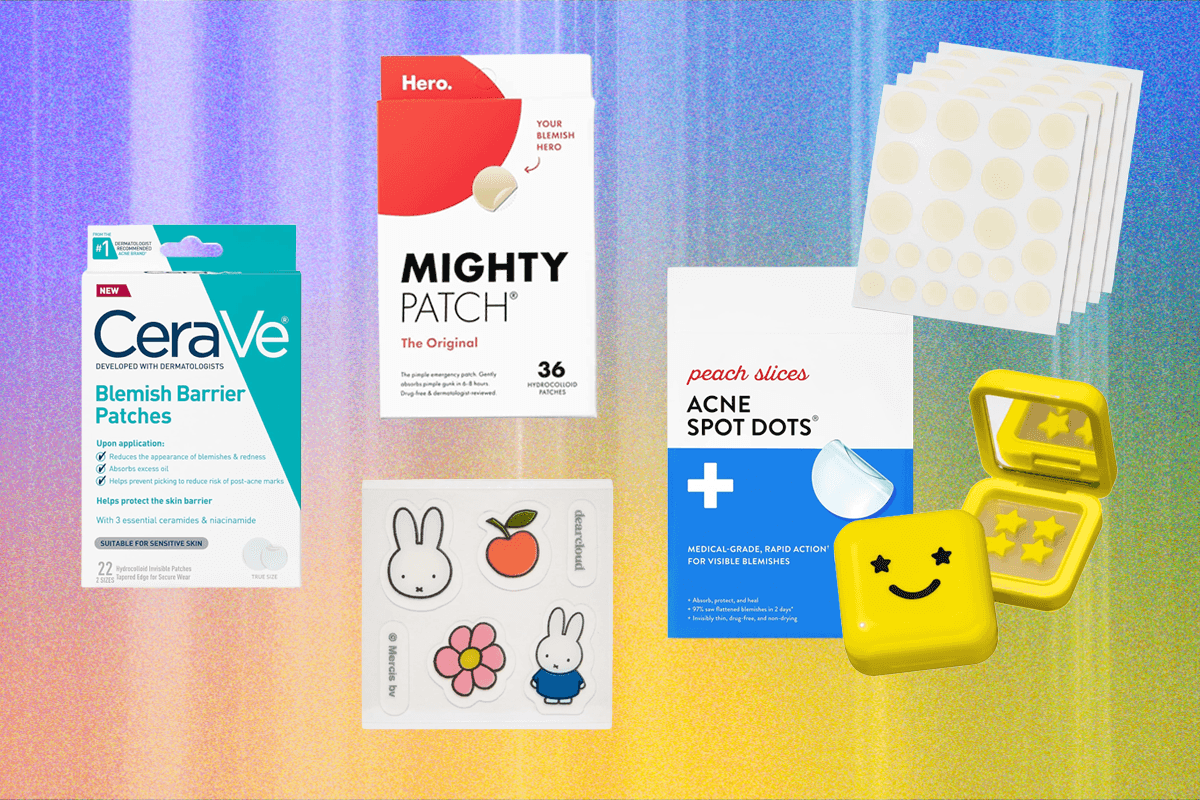How do pimple patches work? Back in the day, getting a zit meant caking on disguising layers of foundation, concealer, powder …or maybe just a strategically angled hairstyle. But now, the game has changed: Why hide a pimple when you can dress it up? No frantic blending or pore-clogging products are required. Today, we’re embracing a radically different (and refreshingly low-key) approach to clogged pores: slapping a bright yellow star-shaped sticker on it and calling it a day.
Welcome to the era of the pimple patch, where blemishes aren’t shameful secrets to conceal but just part of the human experience. While putting a literal sticker on a zit may seem bold, it’s also an effective way to treat blemishes. Here, we dive into the science, benefits, and best ways to rock a hydrocolloid pimple patch.
If you’re interested in skin science, don’t forget to check out our guides to red light therapy masks and LED devices, exosome treatments, and the ancient history of snail mucin.
Updated July 2025: I’ve added Dearcloud Hydrocolloid Blemish Patches, CeraVe Hydrocolloid Blemish Patches, and Peach Slices Acne Spot Dots as new picks. I’ve also updated information, prices, and links.
What Is a Pimple Patch?
In simplest terms, pimple patches are tiny, adhesive stickers made to tackle different types of acne, one blemish at a time. These patches unclog pores and absorb excess fluid, speed up wound healing, and keep you from picking at your skin—no small feat. Pimple patches come in various formulas, with different ingredients for different breakouts, but the most popular are hydrocolloid acne patches.
How Do Pimple Patches Work?
Photograph: Andrew Youngberg
Hydrocolloid patches are a type of wound dressing that helps retain moisture and create a moist, healing environment for pimples, burns, or lesions. “They’re made of a water-attracting material, which is attached to a really thin plastic film,” says cosmetic chemist Michelle Wong. “So if you have an open pimple, for example, it can suck out the pus.”
Although hydrocolloid dressings has been used for wound care since the 1960s (the dressings were originally developed in the 1930s by a dentist), it wasn’t until the early 2010s that pimple patches started showing up on skincare and beauty shelves.
When applied to an inflamed pimple—typically one with fluid—the warmth of your skin softens the lining of the sticker, helping it suck out the impurities and gunk. It also acts as a protective barrier that shields the blemish from further irritation or spread. If you’ve ever pulled off a patch to find the underside coated in an icky white substance, that’s a mix of the hydrocolloid gel and the excess oils pulled from the skin. This healing process also prevents you from picking at the pimple—a habit that can lead to longer healing times, infection, and scarring.
Our Favorite Pimple Patches
Cosrx
Acne Pimple Master Patch
Hero Cosmetics
Mighty Patch Original Patch
dearcloud
x Miffy Hydrocolloid Blemish Patches Refill Set
CeraVe
Hydrocolloid Blemish Patches
Peach Slices
Acne Spot Dots
Other Spot Treatments
“Spot treatments [tend] to contain benzoyl peroxide, salicylic acid, or witch hazel,” writes Lindsey Zubritsky, a board-certified dermatologist at Premier Dermatology and Skin Cancer Center, in an email. “These are active ingredients—while they may work, they can also potentially cause dryness and irritation.” Pure hydrocolloid patches, on the other hand, don’t contain active ingredients, which makes them ideal for sensitive or reactive skin types.
How Often Can You Use Hydrocolloid Patches?
Photograph: Yuliya Sheynina/Getty Images
According to most dermatologists, you can use pimple patches as needed. Zubritsky (aka @dermguru on TikTok) suggests wearing them for up to 12 hours, ideally overnight. But they can also be worn during the day. They’re particularly effective on fluid-filled pimples, such as papules, pustules, or cysts.
“Hydrocolloid patches are considered safe and effective,” writes Zubritsky, “I just wouldn’t recommend relying on them as the sole acne treatment.” While they help treat surface-level blemishes like whiteheads, they don’t prevent outbreaks of acne blemishes, and they don’t treat cystic pimples or blackheads.
Wong adds that if you have oily skin, the patch may not stick as well, though it usually isn’t a major issue. Lastly, those with more melanin-rich skin tones may want to avoid daytime use, as UV exposure could lead to hyperpigmentation where the patch was applied.
Final Tips and Advice
Always clean the affected area before applying a patch. Hydrocolloids seal in whatever’s under them, so you want to start with a cleanser. Dry the area as well—they won’t stick to a damp surface. Popping pimples is a no-no, but if one does happen to burst, a hydrocolloid patch can also help heal open wounds. Some skincare products’ formulations add acne-fighting ingredients like tea tree oil or niacinamide to their patches, so be aware if you have sensitive skin or known allergies.
Meet the Experts
- Michelle Wong, a cosmetic chemist and educator at Lab Muffin in Sydney, Australia.
- Lindsey Zubritsky, MD, FAAD, a board-certified dermatologist at Premier Dermatology and Skin Cancer Center in Ocean Springs, MS.
Power up with unlimited access to WIRED. Get best-in-class reporting that’s too important to ignore for just $2.50 $1 per month for 1 year. Includes unlimited digital access and exclusive subscriber-only content. Subscribe Today.



